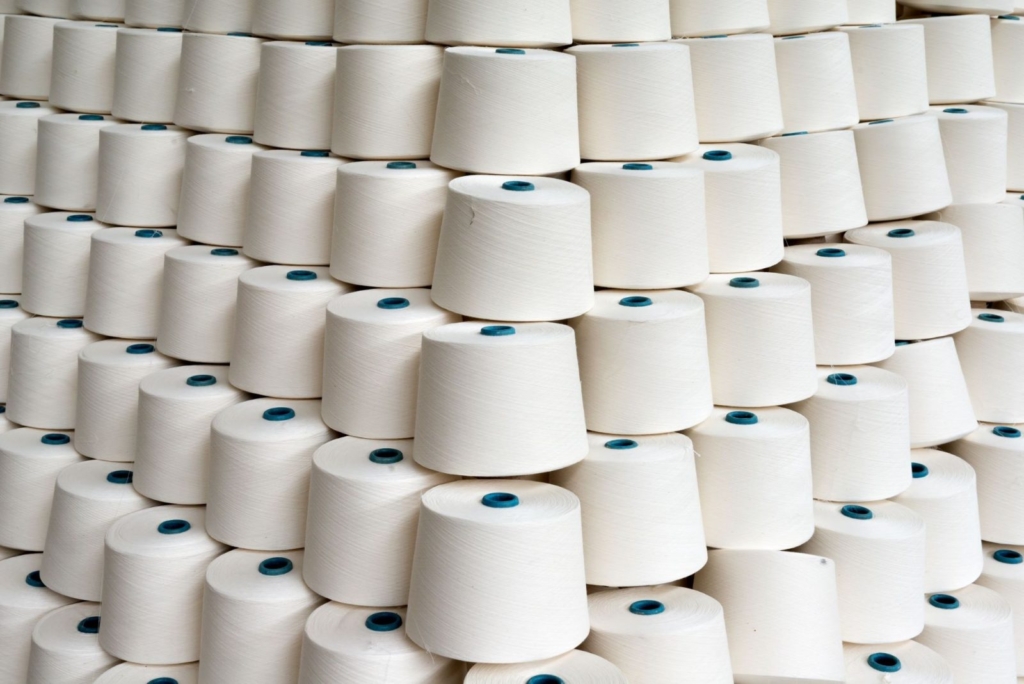
Types of Yarn Package
Tube

A tube of yarn is one of the most common yarn package types. The tubes are predominantly made from plastic or cardboard. Tubes of yarn do not have flanges, meaning they don’t have sides which ensure that the yarn doesn’t come off the package.
Cheese

A cheese of yarn is essentially a larger tube, with a total diameter over 30cm and the ability to hold over 10kg of yarn. These are a good option for large scale production, as they do not need to be replaced as frequently. The cheeses are almost always made from cardboard.
King spool

King spools are normally small packages used to hold yarns for sewing and embroidery. They have an angled flange on one end, which prevents the yarn from sliding off on that end.
Din spool

Din spools commonly hold only small amounts of yarn, which is wound in parallel. Din spools have flanges on both sides that keep the yarn firmly in place, which are necessary when the yarn is wound in parallel.
Cone

Yarn cones are wider at the bottom than the top, aiding the removal of the yarn in the direction of the narrower end. They are made from plastic or cardboard depending on their use case. All cardboard and some plastic cones have solid sides, some plastic cones are given many holes, which allow the yarn to be package dyed.
Cop

Yarn cops are normally loaded with a relatively small amount of yarn on a long package. They are often used in weaving to hold the yarn that will be woven in the weft direction.
Flanges or flangeless?
Flangeless yarn packages the yarn to be pulled off from the top or bottom, which is more efficient and controlled than removing yarn by pulling it off the side. Pulling yarn off the side requires the machinery to apply enough force through the yarn to spin the whole package, which would require more power and may cause the yarn to break. For this reason, yarns which are used quickly and in high volumes will predominantly be on flangeless packages like tubes, cheeses, cones, and cops. These yarns rely on grip and winding method to remain firmly on the package.
Yarn Winding Direction
Yarns can be wound onto their packages in a clockwise or anticlockwise direction called the q direction and p direction respectively. This is determined by looking at the yarn package from the top and seeing whether the thread coming off the package looks like the descender of the q, or the descender of the p. This would be reversed if looking from the bottom of the package, which is why this is always determined by looking at the top of the package. Some twist directions interact poorly with some winding directions.
Yarn Winding Methods
Parallel Yarn Winding
Parallel winding is suited to yarn packages with flanges that can hold the yarn in place, without which the yarn would likely slide off the package. While this is a clear disadvantage, parallel winding does provide some benefits; parallel winding is the most efficient winding method, as it ensures the highest yarn density on the package. It comes with the added benefit of not altering the twist level in the yarn when it is wound onto the package.
Near Parallel Yarn Winding
Near parallel winding is similar to parallel winding, in that the yarn in each layer is laid in parallel, but the orientation of each layer of yarn is off by a small angle to that of the layer below. While a minor difference, this allows the yarn to be more stable on the package, reducing the likelihood that the yarn will slough off the package thus removing the need for flanges.
A near parallel wind allows over withdrawal from the package, but side-withdrawal is not. This means that yarn can be removed from the top or the bottom of the package but does not allow the yarn to be removed in the direction in which it was wound.
Yarn Cross Winding
Cross winding is the most common winding method used for yarns that will be used on machines. Yarn cross winding is where the yarn is wound onto the package at a significant angle to the previous layer, unlike parallel winding and near-parallel winding. It is more convenient for machines to remove yarn, as no mechanism is needed to take the yarn off the package.
This winding method allows yarn to be removed from the package off the ends, meaning that the yarn package doesn’t have to be rotated to allow the yarn to be removed. By using the over-end withdrawal method, machines can remove yarn from packages at a very high rate but doing so may introduce some level of added twist to the yarn. This method is commonly used on tubes, cheeses, cones, and cops.

